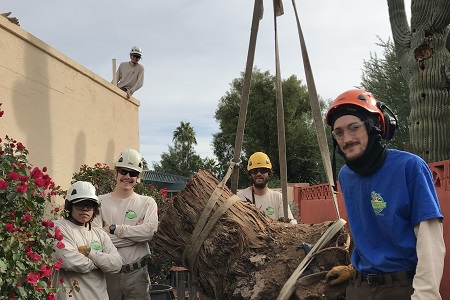Keeping Your Trees Healthy
Showcasing the overall beauty of your home with landscaping not only increases its value, but it keeps your lawn and trees healthy. Trees that grow in forests do very well with only nature’s care, but yard trees need a higher level of maintenance to keep them thriving. Pruning is the most common form of trimming trees, and it requires a certain level of understanding. Improper pruning can be devastating to the life and beauty of a tree.
Every cut made to a tree can affect its growth, so branches should not be removed without a reason. Pruning should be done to remove dead branches, improve form, or to reduce risk. They can also be pruned to help increase light and air infiltration to the tree’s crown or surrounding landscape.

Seasonal Pruning
Minimal pruning and removing dead wood can be done any time during the year. However, by following the seasonal guidelines below, you can maximize the ability of your trees to maintain their structural integrity and overall health. Remember through, individual species may differ in their maintenance needs.
Winter
Pruning during dormancy can result in dynamic new growth in the spring. Waiting for the coldest part of winter pass is best. You may notice “bleeding” or sap flowing, but it is not harmful and will stop as it gets warmer.
Spring
Pruning in the Spring will encourage growth and wound closure. However, there are some diseases, such as oak wilt, that can spread when pruning wounds provide access to pathogens. Be sure you know what kind of trees are in your yard and don’t prune vulnerable species during active transmission periods.
Summer
If your goal is to slow the growth of new and existing branches, pruning should be done soon after seasonal growth is complete. Slowing the growth will reduce the total leaf surface, which reduces the amount of food sent to the roots. This also inhibits the view of unsightly limbs or branches that hang down too far under the weight of the leaves.
Fall
Pruning during the fall is not recommended. Decay and fungi spread their spores in the fall, and healing of cuts is substantially slower during this time of year.
Pruning Techniques
There are different types of pruning that are helpful in keeping a mature tree healthy and strong:
- Cleaning – removes dead, dying or diseased limbs from the crown or top of a tree
- Thinning – strategically removes branches to improve structure as well as increase light infiltration and air circulation at the crown of the tree
- Raising – gets rid of the branches at the base of the tree to provide ample clear
- Reduction – often utility lines are obstructed by trees. Reducing its height or spread is done by pruning back the leaders and branch terminals

Pruning Young Trees
Giving young trees proper care while they are maturing will ensure that they need less corrective pruning in the years to come. Providing structure to the primary limbs or scaffold branches is essential. For most young trees, maintaining a single dominant leader growing upward is best. Do not prune back the tip of this leader or allow secondary branches to outgrow the main leader.
Pruning Palms
Pruning of palm trees is generally done at least twice a year. While it is best for the palm if green fronds remain intact, trimming palms helps to remove dead or dying branches. However, care should be taken to avoid any damage to the terminal bud or trunk. Flowering, and/or fruiting clusters, like coconuts may be pruned as often as every 3 to 4 months to minimize the risk of injury or damage from the heavy fruit. Be careful not to over-prune your palms as they may have slower growth and attract pests. While climbing spikes are fine for some trees, they should not be used to climb palms, as they wound the palm trunk.
Don’t Top Trees When Trimming
Topping is the cutting of tree limbs to stubs or to lateral branches that are not large enough to assume the terminal role. There are several terms that are used to describe topping trees including, “heading,” “tipping,” “hat-racking,” and “rounding over.” This pruning practice is never suggested as it can cause excessive structural damage to your tree and should be avoided.
Alternatives to Tree Topping
As mentioned earlier, some trees must be reduced in height or spread to provide utility line clearance. There are recommended techniques for doing so. Small branches should be removed back to their point of origin. If a larger limb must be shortened, it should be pruned back to a lateral branch that is large enough (at least one-third the diameter of the limb being removed) to assume the terminal role. This method of branch reduction helps to preserve the natural form of the tree. There are times when large cuts are involved, that the tree may not be able to recover its wounds. If there is any concern, the best solution may be to simply remove the tree and replace it with a species that is more appropriate for the site.
When it comes to tree care, both the trees and their owners deserve great service. If you are looking for a professional to take care of your tree trimming needs, our friendly experts are happy to share advice and recommendations. Pair that with excellent pricing and a reputation for service that spans 20 years and you know you’re in good hands. Call or contact PV Trimmers for a free estimate on tree trimming services in Scottsdale today.

